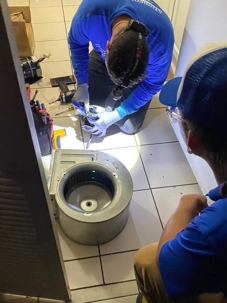Overview of Air Conditioner Compressors
Air conditioner (AC) compressors are crucial components in cooling systems. Often called the “heart” of the HVAC system, they circulate refrigerant, allowing heat exchange to cool indoor environments. The compressor takes in low-pressure refrigerant vapor, compresses it to a high-pressure state, and pushes it through the condenser coils, releasing heat and transforming it into a liquid.
Importance of Compressor AC Repair
Understanding and maintaining your compressor AC Repair ensures your home’s comfort and system efficiency. A malfunctioning compressor can lead to inadequate cooling, increased energy bills, and eventual system failure. Therefore, homeowners must know how to repair or replace their compressors when necessary.
Objective of the Guide
This comprehensive guide aims to equip you with all the necessary knowledge regarding AC compressor repair, from identifying common issues, diagnosing problems, deciding whether to repair or replace, and performing actual repair procedures. It intends to boost your confidence in handling compressor issues, whether you choose a DIY approach or hire a professional.
Understanding Your AC Compressor
What is an AC Compressor?
An AC compressor is a device responsible for compressing refrigerant and circulating it throughout the air conditioning system. It plays a crucial role in maintaining efficient temperature control within your home. It pressurizes the refrigerant, facilitating its flow through the system to achieve cooling.
Components of an AC Compressor
The main components of an AC compressor include:
- Compressor Motor: Powers the unit and drives the compression process.
- Piston or Scroll Mechanism: Responsible for compressing the refrigerant.
- Suction and Discharge Ports: Where refrigerant enters and exits the compressor.
- Crankshaft: Converts rotational motion into linear motion, essential for driving the piston or scroll.
How the Compressor Works
When the AC system calls for cooling, the compressor motor activates, compressing the refrigerant vapor inside its chamber. This compression elevates the refrigerant’s pressure and temperature. The refrigerant then exits the compressor via the discharge port, transitioning into the condenser coil, where the heat absorbed from the indoor air is released. The refrigerant is transformed back into a liquid state to repeat the cycle.
Common Issues with AC Compressors
Symptoms of a Failing Compressor
Awareness of the signs of a failing compressor is essential for timely intervention. Here are common symptoms to watch for:
- Warm Air: If your AC system blows warm air instead of cool, this could indicate a compressor failure.
- Unusual Noises: Sounds like grinding, sneezing, or hissing can signal compressor failure.
- High Energy Bills: An inefficient compressor will consume more power, as reflected in utility bills.
- Frequent Cycling: If your AC compressor cycles on and off irregularly, it may not function correctly.
Causes of Compressor Problems
There are several root causes behind compressor issues:
Refrigerant Leaks
Refrigerant leaks can lead to reduced efficiency, causing the compressor to work harder, ultimately leading to failure.
Electrical Failures
Faulty wiring, blown fuses, or issues with the capacitor can hinder the compressor’s functionality, leading to performance problems.
Mechanical Failures
Piston wear, seizures, or improper oil lubrication can cause mechanical failures in compressors.
Inadequate Maintenance
Lack of regular maintenance can result in dirty coils, blocked suction lines, and damaged components, ultimately affecting compressor performance.
Diagnosing Compressor Issues
Visual Inspection Techniques
Start by visually inspecting your AC unit for signs of damage or wear. Check for:
- Leaks: Look for any visible refrigerant leaks around the compressor unit.
- Dirt and Debris: Ensure coils are clean and the outdoor unit is free from obstructions.
Tools and Equipment for Diagnosis
To effectively diagnose compressor issues, consider acquiring the following tools:
- Multimeter: This is used to check electrical connections and the power supply.
- Manifold Gauge Set: To measure refrigerant pressure and diagnose issues.
- Refrigerant Leak Detector: To identify leaks in the system.
How to Perform a Compressor Check
Performing a basic check includes:
- Power Supply Check: Ensure the unit receives adequate power and that there are no blown fuses or tripped breakers.
- Thermostat Setting Verification: Confirm that the thermostat is set correctly for cooling.
- Refrigerant Level Check: Low refrigerant pressure could indicate leaks.
Understanding Error Codes and Indicators
Many modern AC units display error codes on the thermostat or control board to indicate specific issues. Consulting your user manual or manufacturer resources can help you decipher these codes.
When to Repair vs. Replace
Factors to Consider
When faced with compressor issues, evaluating whether to repair or replace is crucial.
Age of the Unit
If your AC unit is nearing its expected lifespan of 10-15 years, replacement may be the more cost-effective option, especially if other components are aging.
Cost of Repair vs. Replacement
Assess repair quotes against the overall replacement cost. A new unit might be a better investment if repairs are extensive and costly.
Energy Efficiency Considerations
Upgrading to a more energy-efficient compressor or AC unit can save your utility bills significantly.
Pros and Cons of Repairing
Pros
- Generally less expensive than replacement.
- The existing unit may still have a good service life left.
Cons
- Repairs are often only temporary fixes.
- Frequent repairs can add up over time.
Pros and Cons of Replacing
Pros
- New systems often come with warranties.
- Improved energy efficiency and performance.
Cons
- Higher upfront costs.
- Potential for installation complications.
Step-by-Step Guide to Compressor Repair
Safety Precautions
Before starting any repairs, ensure safety precautions are in place, such as:
- Disconnecting the power supply.
- Wearing suitable protective equipment.
Required Tools and Materials
For compressor repair, gather these essential tools:
- Wrench and Socket Set: This is for removing bolts.
- Screwdriver Set: For various components.
- AC Manifold Gauge Set: To check refrigerant pressures.
Removing the Old Compressor
- Recover Refrigerant: Use a recovery machine to extract refrigerant from the system safely.
- Disconnect Electrical Connections: Remove electrical connectors carefully, marking them for reassembly.
- Unfasten and Remove: Unscrew the compressor from the mounting bracket and carefully lift it out.
Installing a New or Repaired Compressor
- Place the New Compressor: Position it correctly, aligning the mounting holes.
- Reconnect Lines and Wires: Attach refrigerant lines and restore electrical connections.
- Test the Installation: Before restarting the system, ensure all connections are secure.
- DIY vs. Professional Repair
Advantages of DIY Repair
- Save on labor costs.
- Gaining hands-on experience with HVAC systems.
Risks of DIY Repair
- A lack of technical knowledge can lead to improper repairs.
- Risk of voiding warranties if not performed by licensed technicians.
Benefits of Hiring a Professional
- Expertise in diagnosing complex issues.
- Access to specialized tools and equipment.
How to Choose a Reliable AC Repair Technician
When searching for a technician:
- Check for proper licensing and certifications.
- Read reviews and ask for recommendations.
- Maintenance Tips to Prevent Compressor Issues
Regular Maintenance Tasks
- Change Air Filters: Dirty filters can strain the compressor.
- Clean Coils Regularly: Prevent dirt buildup that can hinder performance.
Scheduling Professional Inspections
Annual inspections by a licensed HVAC professional can help identify potential issues early.
Understanding Compressor Warranties
What Warranties Typically Cover
Most compressor warranties cover defects in materials and artistry, typically for one year after purchase.
How to File a Warranty Claim
To file a warranty claim, contact the manufacturer with the model and serial number of the compressor.
Upgrading Your AC System
Benefits of Modern Compressors
Modern high-efficiency models can significantly improve energy savings, reduce noise levels, and enhance cooling performance.
Cost-Benefit Analysis of Upgrading
While upgrading involves costs, energy savings and improved performance often justify the investment in modern technology.
Troubleshooting Common Problems
Compressors Won’t Start
This could indicate electrical issues or a faulty thermostat.
Compressors Making Strange Noises
Unusual sounds can signify mechanical problems requiring immediate attention.
Inconsistent Cooling Performance
If the system struggles to maintain temperature, inspect for refrigerant leaks or blocked air filters.
Cost of Compressor Repair and Replacement
Average Repair Costs
The average cost for compressor repairs typically ranges between $200 and $600.
Average Replacement Costs
Replacement costs range from $800 to $2,800, depending on the compressor’s type and model and additional installation requirements.
Factors Influencing Costs
Consider the compressor type, labor rates in your area, and any additional repairs needed when estimating costs.
Impact of Compressor Issues on Home Comfort
Effects on Indoor Temperature
Compressor issues can lead to inconsistent temperatures, making your living space uncomfortable.
Effects on Air Quality
A malfunctioning compressor can negatively impact indoor air quality, leading to the circulation of dust and allergens.
Long-Term Effects on Your HVAC System
Failing to address compressor issues can strain other components, resulting in costly repairs or system replacements.
Legal and Safety Considerations
Regulations and Compliance
Fulfilling regulations, particularly regarding refrigerant handling, is crucial for legal compliance.
Safety Precautions When Handling Refrigerants
Always wear protective gear and follow local regulations when working with refrigerants.
Customer Reviews and Case Studies
Real-life Repair Stories
Customer experiences often provide valuable insight into the effectiveness of various repair solutions.
Lessons Learned from Case Studies
Evaluating case studies can reveal prevalent issues and practical solutions for compressor problems.
Future Trends in Compressor Technology
Innovations in Compressor Design
Continuing advancements in compressor technology promise increased efficiency and reliability.
Predictions for Future Developments
As market demands evolve, expect a greater emphasis on sustainability and energy efficiency in compressor design and operation.
Frequently Asked Questions (FAQs)
What are the signs of a failing AC compressor?
Common signs include fluctuating temperatures, unusual noises, and increased energy bills.
How long does a compressor typically last?
An AC compressor can last between 10 to 15 years with proper maintenance.
Can I repair an AC compressor myself?
While some repairs can be DIY, consulting with a professional for safety is often best.
Glossary of Terms
Common Terminology Related to AC Compressors
- SEER: Seasonal Energy Efficiency Ratio
- HVAC: Heating, Ventilation, and Air Conditioning
Resources and Further Reading
- Recommended Books and Guides: Look for comprehensive HVAC maintenance manuals.
- Online Resources and Tutorials: Check platforms like YouTube for DIY videos.
- Professional Organizations and Associations: Explore the Air Conditioning Contractors of America (ACCA) for more information.
Conclusion
Recap of Key Points
Understanding your AC compressor is vital for maintaining indoor comfort. Regular maintenance, timely repairs, and knowledgeable technicians ensure your system’s longevity and efficiency.
Final Tips for Compressor Care
- Stay proactive with maintenance and repairs.
- Monitor performance and address issues promptly.

